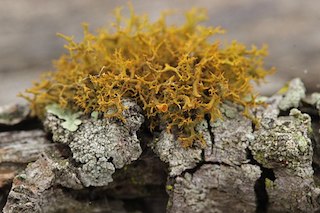 It is always a pleasure to find the rare and beautiful Golden Hair-lichen. Kynance is a good place to search.
It is always a pleasure to find the rare and beautiful Golden Hair-lichen. Kynance is a good place to search.
Photo: Wikimedia Commons (see below for full attribution)
Scientific name: Teloschistes flavicans
Cornish name: ‘Kewny’ is the general word for lichen and moss
Conservation status: Vulnerable and Nationally Scarce in Great Britain; protected under Schedule 8 of the Wildlife and Countryside Act 1981.
 With its beautiful glowing colour and delicate branching structure, it is a treat to come across Golden Hair-lichen. Sadly, it is a much rarer treat than 100 years ago, when its distribution stretched across the south of England into the Midlands and Wales: there is even a record from Scotland in the eighteenth century. Nowadays, its range has greatly contracted, and it is only found in the south-west, with a few isolated populations in Pembrokeshire and Anglesey.
With its beautiful glowing colour and delicate branching structure, it is a treat to come across Golden Hair-lichen. Sadly, it is a much rarer treat than 100 years ago, when its distribution stretched across the south of England into the Midlands and Wales: there is even a record from Scotland in the eighteenth century. Nowadays, its range has greatly contracted, and it is only found in the south-west, with a few isolated populations in Pembrokeshire and Anglesey.
The main problem for Golden Hair-lichen is that, even by usual lichen standards, it is highly sensitive to pollution, especially sulphur dioxide. Increasing air pollution through the southern parts of the country during the twentieth century unfortunately resulted in the elimination of many populations. It has also proved vulnerable to other factors. This lichen can be saxicolous (grow on rocks), terricolous (grow on the ground) or epiphytic (grow on trees). It was epiphytic in many of its inland sites, with a love for old orchards, wayside trees and elms in particular: the loss of orchards and hedgerows, and the death of elms from Dutch Elm disease, meant the loss of much of its habitat. It is now mainly a lichen of windy clifftops, where it particularly favours siliceous rocks such as granite.
Golden Hair-lichen is a fruticose (or shrubby) lichen, up to about 8 cm in diameter, with flattened lobes often branched into pairs: the genus name Teloschistes means ‘split ends’, in reference to the structure of this lichen group. Outside of Britain, its European distribution is atlantic-mediterranean, and it is widespread in tropical and sub-tropical regions.
All is not lost for the surviving populations in Britain, however. One remaining site is Kynance on The Lizard, on the National Nature Reserve, and nationally the lichen is being monitored under Natural England’s Species Recovery Programme.
Did you know…?
…All lichens are formed of a fungus and algae (or cyanobacteria) living in partnership. The jury is still out among the experts as to whether this relationship is parasitic (in this case, the fungus would be parasitic on the algae, which provides it with carbon via photosynthesis) or mutualistic (benefits both partners, with the algae gaining protection and access to habitats it could not otherwise reach).
…An ancient lineage: the genus Teloschistes is very old, perhaps stretching back for millions of years.
More information and references:
Gilbert, O.L. and Purvis, O.W., 1996. Teloschistes flavicans flavicans in Great Britain: distribution and ecology. Lichenologist 28(6): 493–506.
Purvis, W., 2000. Lichens. Natural History Museum, London.
Published: March 2014
Author: Amanda Scott
Photo: Björn S… [CC BY-SA]
